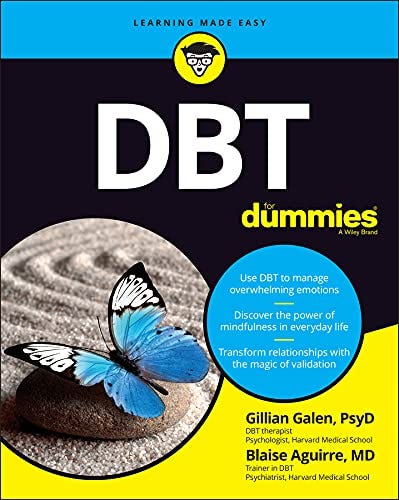The Back Story Of The Book
In the 1980’s Marsha Linehan, PhD, researched, developed and tested a highly successful treatment for Borderline Personality Disorder. She named that treatment Dialectical Behavior Therapy or DBT.
Since then, a significant number of books on the topic of DBT have been published for both consumer and professional readers. In fact, over 1,000 titles about DBT are currently listed on Amazon.
A new book has recently been added to the repository of Dialectical Behavior Therapy literature - DBT For Dummies. Co-authored by two distinguished BPD therapists at McLean Hospital in Massachusetts - Gillian Galen, PsyD, and Blaise Aguirre, MD., the book immediately rose to the top of the Amazon best seller list.
DBT For Dummies is essentially a roadmap for people looking to achieve more hopeful and productive lives. Dr. Gale and Dr. Aguirre deserve their accolades for making that journey less arduous with this timely, insightful and highly readable book.
A Brief History of DBT
In 1993 the very first book about DBT - Cognitive Behavioral Treatment of Borderline Personality Disorder was published by Dr. Linehan, then a Professor of Psychology at the University of Washington in Seattle (she has sincere retired).
In just over 500 pages, Dr. Linehan detailed the development and implementation of an innovative approach to treating people who are unable to effectively control their emotions and their reactions to those emotions.
Combining the change strategies of Cognitive Behavior Therapy with the acceptance practices of Zen Buddhism, Dr. Linehan’s DBT was the first psychological intervention shown to be clinically effective in treating people who were diagnosed with depressed, anxious and prone to self-harming behaviors, including suicide.
Those traits, among several others, are commonly found in people who meet the diagnosis for Borderline Personality Disorder, a patient population that many mental health providers of that era actively sought to avoid. Allegedly, one mental health expert referred to Borderline Personality Disorder as “the leprosy of mental illness”.
That stigma was based on the widely held belief among professionals that BPD was not a curable disorder. The fear of having a patient with BPD commit suicide also dampened their interest. Seven out of ten people with BPD attempt suicide at least once in their lifetimes and 10 percent complete the act. These rates are higher than in any other psychiatric disorder.
The purpose of Dr. Linehan’s book was to provide guidelines for mental health providers on how to more effectively meet the needs of patients who were deeply suffering, poorly understood, frequently misdiagnosed and needlessly stigmatized.
Through a series of federally funded research grants that began in 1980, Linehan was able to demonstrate that DBT proved very helpful for people unable to manage the emotional and behavioral difficulties that define BPD, especially the self-harming and suicidal behaviors, when compared with traditional therapeutic approaches.
Despite these positive results she obtained with DBT, Dr. Linehan concedes that, while highly effective, DBT is not perfect. Despite becoming the best treatment currently available, she hopes that others might improve DBT or develop other treatments that are as effective or more effective than DBT.
The Initial Resistance to DBT
It should not be surprising to learn that many thought leaders in the mental health field initially were skeptical about DBT as an effective therapy. Whether that was based on fears of disruption or gender or other bias is unknown. It’s interesting to note that the term “Dialectical Behavior Therapy” is not included in the title of her book. Fortunately, a significant number of research studies by Linehan and many others that found the effectiveness of DBT to be superior to other treatments dispelled many of the concerns about DBT that were raised early on.
To help disseminate her work more broadly, Dr. Linehan created two organizations. The first was Behavioral Technology (BTech) to teach DBT to therapists, and the other, The Linehan Board of Certification, to identify therapists who are formally trained and who adhere to the protocols and practices of DBT as she designed them. You can learn more the impact of DBT on the BTech website (1)
If You Are Looking For A Trained DBT Therapist.
From the beginning, Dr. Linehan harbored concerns that some providers might ‘cherry pick’ aspects of the complete DBT protocols or not apply the therapy correctly. To counter that concern she created a rigorous adherence training and certification program for providers seeking to learn and practice DBT as it was originally designed.
You can find a catalogue of certified providers and teams on the BTech website. The list is a geographic compilation of therapy teams with at least one member who has completed either the Dialectical Behavior Therapy Intensive Training or the Dialectical Behavior Therapy Foundational Training through BTech or its affiliates. Only members who have completed training are listed.(2)
Dialectical Behavior Therapy is not a quick fix. In fact, it can be a lengthy and challenging endeavor, marked by small steps forward and recurring downward stumbles. Linehan’s mission in developing Dialectical Behavior Therapy was to help people find a way out of their emotional hell. Decades of research on DBT demonstrate that people can, and do, create a meaningful “Life Worth Living”.
Resources






Share this post